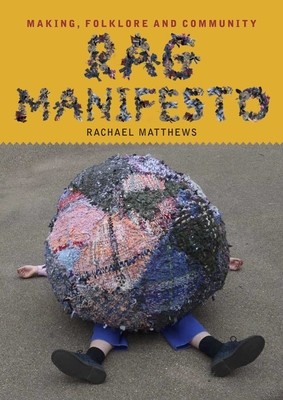
- We will send in 10–14 business days.
- Author: Rachael Matthews
- Publisher: Quickthorn
- ISBN-10: 1739316037
- ISBN-13: 9781739316037
- Format: 16.8 x 23.6 x 0.8 cm, minkšti viršeliai
- Language: English
- SAVE -10% with code: EXTRA
Reviews
Description
It's time to reconsider the value of our waste. In the past rags were valuable commodities you could sell on. Gathering rag and turning it into yarn was rich in the possibility of making things. This Rag Manifesto is a unique, artist's view of the traditional art of rag rug making for this age of the Anthropocene. Projects made in the artist's studio and with a community group, highlight a reverence for our lost textiles, a response to the environmental impact of fast fashion and a proof that rag is a rich resource, wrongly classed as a taboo material. The author Rachael Matthews gives us permission to cut up our old fabrics offering a support structure for decision making and a chart on how to make liberating decisions about destroying a garment - be it a found item or a misguided purchase - and how our actions can develop community as well as our own self-esteem. A modernist interpretation of rag weaving European modernist painters, such as Ben and Winifred Nicholson, became interested in Rag Rug making in the 1920s. Picasso inspired freedom in creativity, using found materials and recognising that 'primitive' art was highly skilled. The art world missed a trick in not accepting these painterly rag works as true art and many have been lost. A century later, post pandemic, the need for a community to gather and make textiles was strengthened by a shared concern about the textile waste found on the streets where they live. This led to the artist founding Rag School, an on-line studio to rediscover the lost ways of making things. This led to a real-life rag studio with East London Textiles Arts, piloting ways that diverse communities everywhere could re-learn how to process textile waste in beautiful ways, caring for each other along the way. The transformation of waste has been a valuable remedy in recovering from the collective trauma of the pandemic: ripping is thrilling, storytelling cathartic, and the craft work a great place of focus and thought.
EXTRA 10 % discount with code: EXTRA
The promotion ends in 22d.18:47:26
The discount code is valid when purchasing from 10 €. Discounts do not stack.
- Author: Rachael Matthews
- Publisher: Quickthorn
- ISBN-10: 1739316037
- ISBN-13: 9781739316037
- Format: 16.8 x 23.6 x 0.8 cm, minkšti viršeliai
- Language: English English
It's time to reconsider the value of our waste. In the past rags were valuable commodities you could sell on. Gathering rag and turning it into yarn was rich in the possibility of making things. This Rag Manifesto is a unique, artist's view of the traditional art of rag rug making for this age of the Anthropocene. Projects made in the artist's studio and with a community group, highlight a reverence for our lost textiles, a response to the environmental impact of fast fashion and a proof that rag is a rich resource, wrongly classed as a taboo material. The author Rachael Matthews gives us permission to cut up our old fabrics offering a support structure for decision making and a chart on how to make liberating decisions about destroying a garment - be it a found item or a misguided purchase - and how our actions can develop community as well as our own self-esteem. A modernist interpretation of rag weaving European modernist painters, such as Ben and Winifred Nicholson, became interested in Rag Rug making in the 1920s. Picasso inspired freedom in creativity, using found materials and recognising that 'primitive' art was highly skilled. The art world missed a trick in not accepting these painterly rag works as true art and many have been lost. A century later, post pandemic, the need for a community to gather and make textiles was strengthened by a shared concern about the textile waste found on the streets where they live. This led to the artist founding Rag School, an on-line studio to rediscover the lost ways of making things. This led to a real-life rag studio with East London Textiles Arts, piloting ways that diverse communities everywhere could re-learn how to process textile waste in beautiful ways, caring for each other along the way. The transformation of waste has been a valuable remedy in recovering from the collective trauma of the pandemic: ripping is thrilling, storytelling cathartic, and the craft work a great place of focus and thought.


Reviews